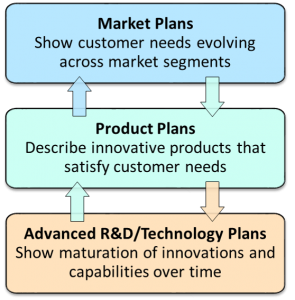
In today’s global markets, the need for innovative solutions is greater than ever. Increased product complexity means high cost of fixing or updating products. Increased competition means that products need to satisfy market needs well to succeed. Concurrent engineering across complex supply-chain also necessitates much better alignment between marketing and R&D. A lack of strategic alignment between marketing and engineering leads to many issues:
- Difficulty adapting to changing market needs
- Limited business/marketing visibility into development
- Differing expectations about project objectives/timeline
- Disconnected plans and wishful launch dates
- Late changes and cost overruns
Here are three steps organizations can take to better align marketing with engineering, product or technology development:
- Disciplined Roadmaps
- Structured Interdependency Tracking T
- Formal Reviews
Disciplined Roadmaps: Most organizations develop market, product and technology plans. However, for sustained alignment we need to become more disciplined about planning. First step is to present all plans in a consistent, easy to understand format across disciplines. Second, we need to standardize a set of terminology to describe plans (product family names, major component names, technology names, market segment names, etc). This will ensure everyone can understand the true intent of the plan. Depending on the product, technology and market complexity, standardization of formats and terminology may require simple templates or software tools.
Structured interdependency tracking: Once we have standardized representation of various plans, the next step is to track where these plans link with each other and track these interdependencies. As changes happens either in engineering or in marketing, these interdependencies will help coordinate efforts across disciplines. Since individual roadmap visualizations are unable to track these dependencies, we need to use a separate approach to do so. Again, depending on organizational complexity, an Excel spreadsheet might suffice or software tools may be necessary.
Formal Reviews: Roadmaps tend to get misaligned because of changes. Periodic (quarterly) reviews of these plans will provide a forcing function to make sure all disciplines remain aligned. The frequency of these reviews can be adjusted based on product lifecycle. Work done in steps 1 and 2 will make these reviews much easier. It is also possible to combine these reviews with portfolio or business strategy reviews
Once done these three simple steps will provide significant benefits:
- Deliver more innovations and products to market
- Rapidly change the R&D portfolio to reflect market changes
- Optimize resource allocation to accelerate strategic and market-critical products
- Automate change coordination across disciplines and locations
